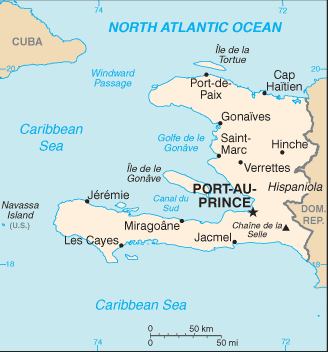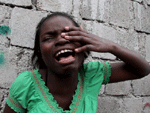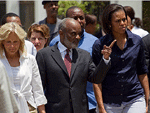|
|
Flag description: two equal horizontal bands of blue (top) and red with a centered white rectangle bearing the coat of arms, which contains a palm tree flanked by flags and two cannons above the motto "L'Union Fait la Force" ("Unity creates strength")
NAME:
POPULATION: 8,800,000
(2007)
ETHNIC GROUPS: Mestizo (69%);
white (17%); black (9%); Indian (5%)
CAPITAL:
LANGUAGES: French
(50%) and Créole/Créyol (99%) are both official languages.
RELIGION: Roman
Catholicism (80%); Protestant (16%); Vodou (50%)
LIFE EXPECTANCY 57
LITERACY: 52%
GOVERNMENT: Democratic
republic
President: René
Préval
Constitution 1987
POLITICAL PARTIES
AND POWER GROUPS: 30
MILITARY: No
military forces since 2007
ECONOMY: Bauxite,
copper, calcium carbonate, gold, marble, hydropower; manufactures, coffee,
oils, cocoa, mangoes
POVERTY:
MONEY: Gourde
(HTG) (41 = $1.0 US; 2007)
GEOGRAPHY: Surrounded
on three sides by Caribbean; tropical climate, but semi-arid in mountains due
to deforestation;
HISTORY:
Pre-Colonial Taíno-Arawak people
called their land Bohio and/or Quisqueya
1492 La
Española island discovered by
1492-1664 Colonial
rule by Spain.
1493 Capitol
of Santo Domingo founded.
1492-1517 99% of the
Taíno people died by 1517.
1664 France
claimed western 1/3 of the island, but it was not officially a French colony
until 1697.
1697 Spain
ceded western 1/3 of island to France in the Treaty of Ryswick at the
conclusion of the Nine Years War (France vs. Spain, England, Holy Roman Empire,
and United Provinces of Holland and Belgium); France named the western 1/3 of
the Island of Hispaniola Saint
Domingue.
1697-1804
1734-1803 Toussaint Louverture,
black national independence hero.
1791 Toussaint
Louverture led anti-slavery revolution as favoring Spanish monarchy
1794 Toussaint
Louverture switched to French Revolutionary army because the French
revolutionaries had outlawed slavery
1801 Toussaint
Louverture achieved relative stability, harmony, and peace
1802 Napoléon
sent French invasion army to destroy Toussaint's black rule and to reestablish
white plantation owners; Toussaint captured (died in 1803 in French prison)
1802-1803 Jean-Jacques
Dessalines, Henri Christophe, and Alexandre Pétion continued black
revolution, defeating French army
1804 January
1:
1804
– 1806 Dessalines:
ruler and then emperor (assassinated 1804)
1805-1820 Henri Christophe
built his palace of Sans Souci and the giant fortress of the Citadelle la
Ferrière with 20,000 (virtually) slave laborers.
1806
– 1820 Haiti
divided into northern kingdom (Henri Christophe; king) and southern republic
(Pétion; president; “Papa Bon-Coeur”).
1820 President
Jean-Pierre Boyer united Haiti under one government;
1822
– 1844 Haiti
reunited with Santo Domingo as one nation when, in 1822, Boyer’s Haitian
army invaded Santo Domingo (the Spanish 2/3 of Hispaniola) and he abolished
slavery; (La República Dominicana separated from Haiti in 1844 along
racial, cultural, and linguistics lines).
1825 Pres.
Boyer gets international recognition from France by signing a treaty according
to which Haiti would pay reparations to France’s former slave owners for
the loss of their slaves; these reparations last, intermittently, until the
1940’s, and they turn Haiti into a debtor nation, in effect, the
world’s first Third World country.
1915
– 1934 U.S.A. invaded
and occupied
1957
- 1971 Dr.
François Duvalier (Papa Doc) was dictator; ruled with army and Tonton
Macoutes (brutal militia)
1971
– 1986 Jean-Claude
Duvalier (son of Papa Doc) was dictator (president for life)
1990
– 1991 Jean-Bertrand
Aristide elected and then overthrown by army
1991
– 1994 Military
dictatorship
1994
- 1996 U.S.A. army
invasion restores Aristide as president
1996 - 2000 René
Préval president
2001
– 2004 President
Jean-Bertrand Aristide
2004 Military
coup (with help from U.S.A.) overthrew Aristide.
2006-2011 René
Préval elected president
2010 (January
12) Major earthquake (7.0) with numerous aftershocks devastate Haiti. For some
early photos of the destruction in Port-au-Prince, click on the following
image:
2010 (April
13) Michelle Obama and Jill Biden get a tour of Port-au-Prince by Haitian
President René Préval.


